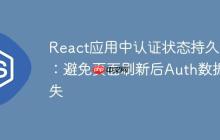
本文旨在解决React应用中页面刷新后认证(Auth)状态(如用户ID、Token)丢失的问题。核心原因在于React组件在刷新时会重新挂载,导致Context API或useState管理的瞬时状态被重置。教程将详细阐述如何通过利用浏览器localStorage实现认证数据的持久化,确保用户体验的连续性,并提供具体的代码示例与最佳实践。
问题分析:页面刷新导致认证状态丢失
在react单页应用中,当用户执行页面刷新操作时,整个应用会重新加载。这意味着所有组件都会重新挂载,并且由usestate或react context api管理的瞬时状态都会被初始化为其默认值。对于认证状态(如用户id auth.id、认证token、用户角色等),如果这些数据仅存储在组件的内部状态或context中,那么在页面刷新后,它们将丢失,导致用户需要重新登录或应用无法获取到必要的认证信息。
在提供的代码示例中,useAuth自定义Hook通过AuthContext管理认证状态。AuthContext的AuthProvider组件内部使用useState({})来初始化auth对象。虽然在useEffect中尝试从localStorage加载数据,但如果localStorage中没有数据,或者在某些情况下useEffect的执行时机与组件渲染的依赖关系处理不当,就可能导致auth对象在初始渲染时为空,或者在刷新后未能及时从localStorage恢复。
解决方案:基于LocalStorage的认证状态持久化
为了解决页面刷新导致认证状态丢失的问题,最常见的做法是将认证相关的数据存储在客户端的持久化存储中,例如localStorage。localStorage允许浏览器存储键值对数据,并且这些数据在浏览器关闭后仍然存在,直到被显式清除。
实现认证状态持久化的核心思想是:
- 存储数据: 在用户成功登录或认证状态发生变化时,将认证信息(如accessToken、roles、userId)存储到localStorage中。
- 恢复数据: 在应用启动或AuthProvider组件挂载时,从localStorage中读取这些数据,并将其设置回认证状态。
1. 优化 AuthContext Provider
AuthContext的AuthProvider是管理全局认证状态的关键。我们需要确保它在组件挂载时尝试从localStorage加载数据。
// AuthContext.js
import { createContext, useState, useEffect } from "react";
const AuthContext = createContext({});
export const AuthProvider = ({ children }) => {
// auth 初始值设为 null 或一个明确的空对象,等待从 localStorage 加载
// loading 状态用于指示认证数据是否已加载完成
const [auth, setAuth] = useState(null);
const [loading, setLoading] = useState(true); // 初始为true,表示正在加载认证数据
useEffect(() => {
const loadAuthData = () => {
try {
const storedToken = localStorage.getItem("accessToken");
const storedRoles = localStorage.getItem("roles");
const storedId = localStorage.getItem("userId");
if (storedToken && storedRoles && storedId) {
// 注意:localStorage 存储的是字符串,需要 JSON.parse 解析回原始类型
const token = JSON.parse(storedToken);
const roles = JSON.parse(storedRoles);
const id = JSON.parse(storedId);
setAuth({ token, roles, id });
} else {
// 如果 localStorage 中没有完整数据,则将 auth 设置为空对象
setAuth({});
}
} catch (error) {
console.error("Failed to load auth data from localStorage:", error);
// 发生错误时也设置为空对象,并确保 loading 结束
setAuth({});
} finally {
setLoading(false); // 数据加载完毕,无论成功与否
}
};
loadAuthData();
}, []); // 空依赖数组确保只在组件挂载时执行一次
// 提供一个 logout 函数,用于清除认证状态和 localStorage
const logout = () => {
setAuth({}); // 清空 auth 状态
localStorage.removeItem("accessToken");
localStorage.removeItem("roles");
localStorage.removeItem("userId");
};
// 假设在登录成功时,你会调用 setAuth 并将数据存入 localStorage
const updateAuthAndPersist = (newAuthData) => {
setAuth(newAuthData);
localStorage.setItem("accessToken", JSON.stringify(newAuthData.token));
localStorage.setItem("roles", JSON.stringify(newAuthData.roles));
localStorage.setItem("userId", JSON.stringify(newAuthData.id));
};
return (
<AuthContext.Provider value={{ auth, setAuth: updateAuthAndPersist, loading, logout }}>
{children}
</AuthContext.Provider>
);
};
export default AuthContext;
关键改进点:
- auth 初始值: 将auth的初始状态设置为null,表示尚未加载。当loading为true时,组件可以显示加载指示器,避免在认证数据未加载完成时进行操作。
-
useEffect 加载逻辑: 在useEffect中,我们尝试从localStorage获取accessToken、roles和userId。
- JSON.parse: localStorage存储的所有值都是字符串。如果存储的是对象或数组,必须先用JSON.stringify将其序列化为字符串,再用JSON.parse解析回来。
- 完整性检查: 检查所有必要的认证数据(storedToken, storedRoles, storedId)是否存在。只有当它们都存在时,才认为认证数据是完整的并进行恢复。
- 错误处理: 使用try-catch块来捕获JSON.parse可能抛出的错误,以增强健壮性。
- loading 状态: 引入loading状态,在数据从localStorage加载完成前为true,加载完成后(无论成功与否)设置为false。这对于需要依赖auth数据的组件来说非常重要,它们可以根据loading状态来决定是否渲染内容或执行操作。
- logout 函数: 提供一个logout函数,用于清除auth状态并移除localStorage中的数据。
- updateAuthAndPersist 函数: 这是一个建议的封装函数,当你在应用中更新auth状态时(例如用户登录成功),应该调用这个函数,它会同时更新Context状态并将数据持久化到localStorage。
2. 在应用组件中使用 useAuth
在依赖认证状态的组件中(例如Exercises组件),应该利用loading状态来确保在auth数据可用后再进行操作。
// Exercises.js
import React, { useState, useEffect } from "react";
import { useParams, useNavigate } from "react-router-dom";
import styles from "./ExercisePage.module.css";
import api from "../../apis/requestService";
import useAuth from "../../hooks/useAuth"; // 确保引入的是优化后的 useAuth
function Exercises() {
const { setAuth, auth, loading } = useAuth(); // 获取 auth, setAuth, loading
const { id } = useParams();
const navigate = useNavigate();
const [requests, setRequests] = useState([]);
const [exerciseData, setExerciseData] = useState({
weight: "",
reps: "",
exerciseId: id,
date: null,
});
const [err, setErr] = useState("");
const [popupStyle, showPopup] = useState("hide");
const { weight, reps } = exerciseData;
useEffect(() => {
// 只有当 auth 数据加载完成且 auth.id 存在时才进行 API 调用
if (!loading && auth && auth.id) {
setExerciseData((prevData) => ({
...prevData,
exerciseId: id,
date: new Date(),
}));
api.getUserExercises(id).then((response) => {
setRequests(response.data);
}).catch(error => {
console.error("Failed to fetch user exercises:", error);
setErr("Failed to load exercises.");
});
} else if (!loading && (!auth || !auth.id)) {
// 如果加载完成但 auth.id 为空,可能需要重定向到登录页
// navigate('/login');
console.log("Auth ID is null or not loaded, cannot fetch exercises.");
setRequests([]); // 清空请求,避免显示旧数据
}
}, [id, auth, loading]); // 依赖 auth 和 loading 状态
const onInputChange = (e) => {
setExerciseData({ ...exerciseData, [e.target.name]: e.target.value });
};
const onSubmit = (e) => {
e.preventDefault();
// 在提交前再次检查 auth.id 是否存在
if (!auth || !auth.id) {
setErr("User not authenticated. Please log in.");
popup();
return;
}
console.log("User id: " + auth.id);
const updatedExerciseData = {
...exerciseData,
userId: auth.id,
date: new Date(),
};
api
.createRequest(updatedExerciseData)
.then((response) => {
if (response.data.id) {
// 这里应该调用 getUserExercises(auth.id) 而不是 (id)
// 因为 getUserExercises 可能是获取特定用户的所有练习
return api.getUserExercises(auth.id);
} else {
throw new Error("An error occurred while creating the request.");
}
})
.then((response) => {
setRequests(response.data);
setExerciseData({ ...updatedExerciseData, weight: "", reps: "" });
setErr(""); // 清除错误信息
popup(); // 显示成功提示
})
.catch((error) => {
console.error(error);
setErr("An error occurred while creating the request.");
popup(); // 显示错误提示
});
};
const popup = () => {
showPopup("exercise-popup");
setTimeout(() => showPopup("hide"), 3000);
};
// 在 auth 数据加载完成前显示加载状态
if (loading) {
return <div className={styles.wrapper}>Loading authentication data...</div>;
}
// 如果 auth.id 为空,可以显示未认证提示或重定向
if (!auth || !auth.id) {
return <div className={styles.wrapper}>Please log in to view and set exercises.</div>;
}
return (
<div className={styles.wrapper}>
<div className={styles.content}>
{requests.length > 0 ? (
requests.map((request, index) => (
<div key={index} className={styles.requestBox}>
<div className={styles.requestDetails}>
<h2>{request.exercise.name}</h2>
<p>{request.exercise.description}</p>
</div>
@@##@@
<div className={styles.requestInfo}>
<p>Weight: {request.weight} kg</p>
<p>Reps: {request.reps}</p>
<p>Date: {new Date(request.date).toLocaleDateString()}</p>
</div>
</div>
))
) : (
<p>No exercises assigned yet.</p>
)}
</div>
<form onSubmit={(e) => onSubmit(e)} className={styles.exerciseForm}>
<h1 className={styles.h1Text}>
Set <br /> Exercise
</h1>
<div className={styles.inputContainer}>
<label htmlFor="weight" className={styles.inputLabel}>
Enter weight
</label>
<input
id="weight"
name="weight"
type="number"
value={weight}
min="0"
onChange={onInputChange}
className={styles.inputBox}
/>
</div>
<div className={styles.inputContainer}>
<label htmlFor="reps" className={styles.inputLabel}>
Enter reps
</label>
<input
id="reps"
name="reps"
type="number"
value={reps}
min="0"
onChange={onInputChange}
className={styles.inputBox}
/>
</div>
<button className={styles.exerciseBtn} type="submit">
+
</button>
<div className={popupStyle}>
<h3>{err}</h3>
</div>
</form>
</div>
);
}
export default Exercises;
关键改进点:
- 处理loading状态: 在组件的渲染逻辑中,首先检查loading状态。如果loading为true,则渲染一个加载指示器。这可以防止在认证数据从localStorage加载完成之前,组件尝试使用可能为空的auth.id。
- 依赖auth和loading: useEffect钩子现在依赖于auth对象和loading状态。当loading变为false且auth对象(特别是auth.id)存在时,才执行获取用户练习的API调用。
- 提交前的检查: 在onSubmit函数中,添加了对auth和auth.id的再次检查,确保在发送请求前用户是已认证的。
注意事项与最佳实践
- 数据敏感性: localStorage并不是一个绝对安全的存储位置。它容易受到XSS(跨站脚本攻击)的影响。对于高度敏感的认证令牌,更推荐使用HttpOnly的cookie,因为它们无法通过JavaScript访问,从而降低XSS风险。然而,对于用户ID和角色这类非敏感信息,localStorage是一个便捷的选择。
- 数据序列化/反序列化: localStorage只能存储字符串。因此,在存储JavaScript对象或数组时,务必使用JSON.stringify()进行序列化;在读取时,使用JSON.parse()进行反序列化。
- 错误处理: 在JSON.parse()操作中添加try-catch块,以防存储的字符串不是有效的JSON格式,避免应用崩溃。
- 初始加载状态: 合理管理loading状态至关重要。它能确保你的应用在认证数据完全加载并可用之前,不会尝试渲染或执行依赖这些数据的操作,从而避免运行时错误并提供更好的用户体验。
- 登录/登出流程: 确保在用户登录成功时,调用updateAuthAndPersist(或类似的函数)来保存数据;在用户登出时,调用logout来清除localStorage中的数据。
-
替代方案:
- sessionStorage: 类似于localStorage,但数据仅在当前浏览器会话期间有效,关闭浏览器标签页或窗口后数据即被清除。适用于需要临时存储的数据。
- Redux Persist / Zustand Persist: 对于使用Redux或Zustand等状态管理库的应用,有专门的持久化插件,可以更方便地将整个或部分状态树持久化到localStorage或其他存储。
- 服务器端会话管理: 更复杂的认证系统会依赖服务器端会话或JWT(JSON Web Tokens)的验证。客户端通常只存储JWT,并在每次请求时将其发送给服务器进行验证。
总结
通过在AuthContext的AuthProvider中利用useEffect和localStorage,我们能够有效地在React应用中实现认证状态的持久化,从而解决页面刷新后auth.id等数据丢失的问题。这种方法确保了用户在刷新页面后无需重新登录,极大地提升了用户体验。同时,合理管理加载状态和遵循安全最佳实践是构建健壮可靠认证系统的关键。





































暂无评论内容